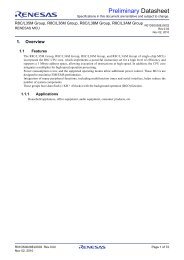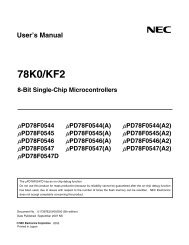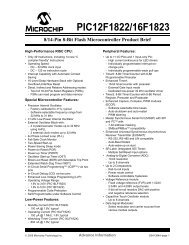xmega a3u - Elfa
xmega a3u - Elfa
xmega a3u - Elfa
You also want an ePaper? Increase the reach of your titles
YUMPU automatically turns print PDFs into web optimized ePapers that Google loves.
XMEGA A3U<br />
10.3.1 32kHz Ultra Low Power Internal Oscillator<br />
This oscillator provides an approximate 32kHz clock. The 32kHz ultra low power (ULP) internal<br />
oscillator is a very low power clock source, and it is not designed for high accuracy. The oscillator<br />
employs a built-in prescaler that provides a 1kHz output. The oscillator is automatically<br />
enabled/disabled when it is used as clock source for any part of the device. This oscillator can<br />
be selected as the clock source for the RTC.<br />
10.3.2 32.768kHz Calibrated Internal Oscillator<br />
10.3.3 32.768kHz Crystal Oscillator<br />
10.3.4 0.4 - 16MHz Crystal Oscillator<br />
This oscillator provides an approximate 32.768kHz clock. It is calibrated during production to<br />
provide a default frequency close to its nominal frequency. The calibration register can also be<br />
written from software for run-time calibration of the oscillator frequency. The oscillator employs a<br />
built-in prescaler, which provides both a 32.768kHz output and a 1.024kHz output.<br />
A 32.768kHz crystal oscillator can be connected between the TOSC1 and TOSC2 pins and<br />
enables a dedicated low frequency oscillator input circuit. A low power mode with reduced voltage<br />
swing on TOSC2 is available. This oscillator can be used as a clock source for the system<br />
clock and RTC, and as the DFLL reference clock.<br />
This oscillator can operate in four different modes optimized for different frequency ranges, all<br />
within 0.4 - 16MHz.<br />
10.3.5 2MHz Run-time Calibrated Internal Oscillator<br />
The 2MHz run-time calibrated internal oscillator is the default system clock source after reset. It<br />
is calibrated during production to provide a default frequency close to its nominal frequency. A<br />
DFLL can be enabled for automatic run-time calibration of the oscillator to compensate for temperature<br />
and voltage drift and optimize the oscillator accuracy.<br />
10.3.6 32MHz Run-time Calibrated Internal Oscillator<br />
10.3.7 External Clock Sources<br />
10.3.8 PLL with 1x-31x Multiplication Factor<br />
The 32MHz run-time calibrated internal oscillator is a high-frequency oscillator. It is calibrated<br />
during production to provide a default frequency close to its nominal frequency. A digital frequency<br />
looked loop (DFLL) can be enabled for automatic run-time calibration of the oscillator to<br />
compensate for temperature and voltage drift and optimize the oscillator accuracy. This oscillator<br />
can also be adjusted and calibrated to any frequency between 30MHz and 55MHz. The<br />
production signature row contains 48MHz calibration values intended used when the oscillator is<br />
used a full-speed USB clock source.<br />
The XTAL1 and XTAL2 pins can be used to drive an external oscillator, either a quartz crystal or<br />
a ceramic resonator. XTAL1 can be used as input for an external clock signal. The TOSC1 and<br />
TOSC2 pins is dedicated to driving a 32.768kHz crystal oscillator.<br />
The built-in phase locked loop (PLL) can be used to generate a high-frequency system clock.<br />
The PLL has a user-selectable multiplication factor of from 1 to 31. In combination with the prescalers,<br />
this gives a wide range of output frequencies from all clock sources.<br />
8386B–AVR–12/11<br />
22

















